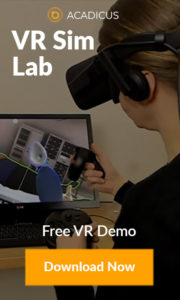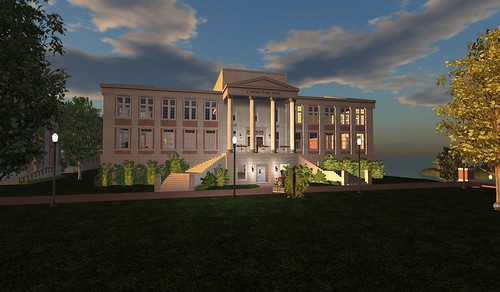
I recently gave a presentation at the Virtual World Best Practices in Education (VWBPE) conference, and talked about some ideas for making the most of virtual education spaces. While working with the University of Alabama to help guide them in developing their virtual campus, their project has become a great case study in how these ideas can be put into practice:
- Replicating iconic real world buildings: For a purely virtual campus where anything is possible, some might wonder why replicating buildings based in the physical world would have any value. In this case, we replicated 2 iconic buildings from the campus in order to provide a sense of what the physical campus is like, and to help tie the virtual and physical destinations with similar architectural character.
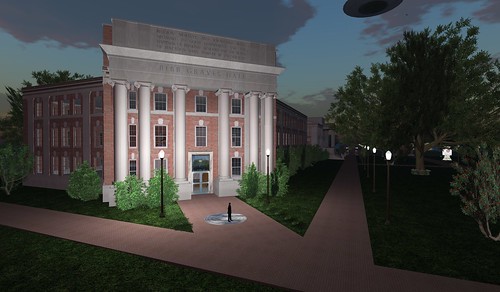
- Engaging students and faculty in creating the virtual presence:
- Instead of hiring a content creator to build everything, the University hired me to train one of their students to build several elements of the virtual campus.
- Balancing Real and Virtual:
- Instead of building everything on the main ‘ground’ level, the University of Alabama has a series of platforms available to instructors, students and individual classes as needed.
- Flexibility / Fluidity:
- Instead of building rigid and unchanging classroom spaces, the platform structures are flexible insofar as they can be created, moved and deleted as needed. This enables the main public campus to remain stable and familiar, while retaining a high degree of flexibility in scaling their use of the virtual classrooms.
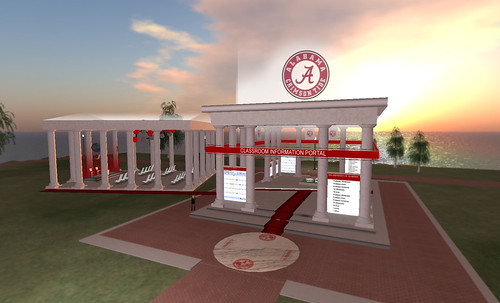
- Emphasis on User Generated Content:
- Additional departments within the University have learned the building tools, and built their own destinations. These places are far more lively and dynamic than education-related builds created entirely by a developer or professional content creator.
- When asked to build a virtual school house, or classroom space, we instead engaged Studio Wikitecture and invited the University students and faculty along with the rest of the virtual community to work together collaboratively to ‘Re-invent the virtual classroom.’
- Part of what the Wikitecture group delivered was the option of adding platforms in the space above the main level. These platform designs can be changed to suit the visitor’s taste by clicking on a sign and choosing from pre-loaded classroom designs, or an empty platform can be added that enables students and faculty to create their own environment.
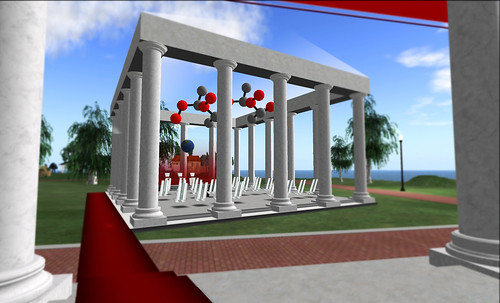
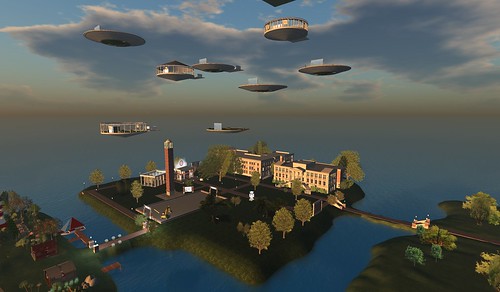
Here is a brief outline of the rest of the material I covered:
- Comparisons of virtual and real architecture
- Main ideas
- Virtual architecture is less rigid, and far more flexible than physical architecture
- Second Life is a ‘user-generated’ environment, and places that are built exclusively by professional content creators that do not engage the end-users in the creation process are often the most dull and lifeless places in all of SL – no matter how perfectly built or well designed they might be.
- Virtual campus spaces should engage as many individuals – faculty, students, community members – as possible – not just one person who goes off to build everything… that’s just as bad or worse than hiring a content developer to build everything for you.
- Architecture should be driven by the end-use, in an ongoing and constantly evolving design process that doesn’t have an arbitrary ‘end’. Virtual architecture doesn’t have to shape us…we can and should keep shaping it.
- People building virtual education spaces are building the foundation for their school’s future virtual endeavors, and have an opportunity to re-think what education means in a virtual environment – not just importing the way we do things in real life.
- Main ideas
- Best practices in developing virtual architecture – framework for approaching projects, borrowing and re-mixing some elements from the AIA’s Handbook for Professional Practice
- Predesign
- Gathering resources, use-cases, program development, construction schedule, context analysis, project budget, architectural style, replica vs. virtual, precedent studies
- Schematic Design
- Blocking diagrams, wayfinding, feedback, etc.
- Construction
- groups, permissions, building teams, etc.
- Predesign
- Case Study: ‘Re-Inventing the Virtual Classroom’ with the University of Alabama
- Wikitecture overview
- Process
- methodology
- Description of the process
- Brief and analysis of the end result
- Concluding thoughts
- Can students, faculty and community members design their own physical-world spaces in the future? Can physical architecture be as dynamic and participatory as virtual architecture?
- Wikitecture overview
Many thanks for Gianna Borgnine for moderating, and to everyone who helped organize this conference. Also, thanks to La Fundación Global Democracia y Desarrollo (FUNGLODE) for sponsoring this presentation.
If you have a project in mind, and could use some guidance in building and designing it, please contact us via info@archvirtual.com or calling 608-219-9318.

